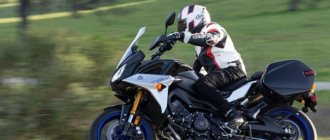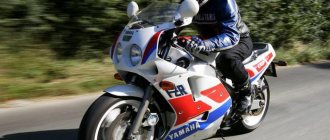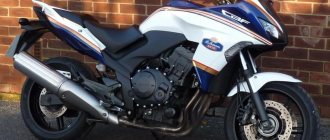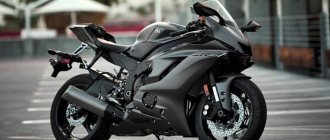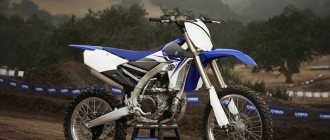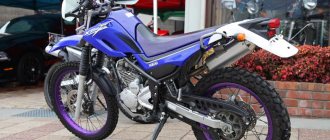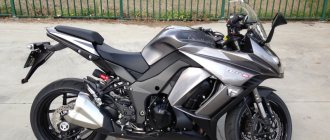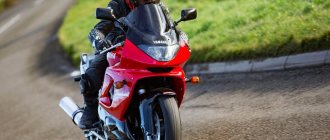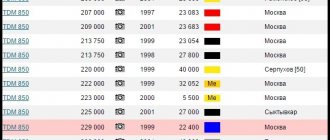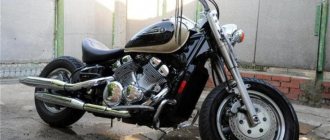| Yamaha YZF1000R Thunderace (1996-2001) |
Yamaha YZF1000R Thunderace sports motorcycle model
appeared in 1996, replacing the Yamaha FZR1000 model. The motorcycle was aimed at the Japanese export market of Europe and North America, but was also presented in small quantities at Japanese auctions. The Thunderace is the ancestor of the flagship Yamaha YZF-R1.
The Yamaha YZF1000R Thunderace was built on the basis of the engine from the FZR1000 (the updated version received a lighter crankshaft and pistons, as well as new larger carburetors with throttle position sensors), which did not produce more power, but due to modifications it became more torquey at medium speeds. The Thunderace 1000 frame is an aluminum Deltabox design, modified from the Yamaha YZF750R.
The main features of the Yamaha YZF1000R Thunderace include a sporty Deltabox aluminum frame, fully adjustable suspension, powerful Nissin Sumitomo 4-piston front brakes, a 20-liter fuel tank, a 5-speed gearbox and a 224 kg curb weight.
Yamaha's flagship sports model, the YZF-R1, was introduced to the world in 1998, although the Thunderace was available until 2001. Meanwhile, with the release of the R1, the Yamaha YZF1000R Thunderace began to position itself as a sports tourer. A similar situation occurred with the younger version of the Yamaha YZF600R Thundercat, which, after the release of the Yamaha R6, also began to be considered a sports touring model.
The main competitors of the Yamaha YZF1000R Thunderace in the class:
- Honda CBR900RR/919RR Fireblade
- Honda CBR1000F
- Kawasaki ZZ-R1100
- Suzuki RF900
Brief history of the model
- 1996 - start of production and sales of the Yamaha YZF1000R Thunderace model.
Model
: Yamaha Thunderace 1000 (Europe).
Factory designation
: 4SV1, 4VD1, 4VE1, 4VF1, 4VG1, 4WN1.
- 1997 - no significant changes.
Model
: Yamaha Thunderace 1000 (Europe, North America).
Factory designation
: 4SV3, 4VD2, 4VE2, 4VF2, 4WN2, 4YW1, 4YW2.
- 1998 - based on the Yamaha YZF1000R Thunderace, the first generation of the flagship Yamaha YZF-R1 appears. However, Thunderace continues to be produced in parallel.
Model
: Yamaha Thunderace 1000 (Europe).
Factory designation
: 4SV4, 4VD3, 4VD4, 4VF3.
- 1999 - model not produced.
- 2000 - no significant changes.
Model
: Yamaha Thunderace 1000 (Europe).
Factory designation
: 4SV5, 4VD5, 4VD6, 4VF4.
- 2001 is the last year of production.
Model
: Yamaha Thunderace 1000 (Europe).
Factory designation
: 4SV6, 4VD7, 4VD8, 4VF5.
Advantages and disadvantages of a motorcycle
Like any other motorcycle, the Yamaha YZF 1000 Thunderace has a number of advantages and disadvantages that must be considered before purchasing. The advantages include a high-quality five-channel gearbox, which is typical for many Yamaha models, and a successful motorcycle design that has remained relevant for a long time. In addition, it is worth noting the suspension with a good range of adjustment, a comfortable fit even for short people, as well as an excellent braking system.
The motorcycle also has disadvantages, however, they are minor. For example, many owners complain about the not very comfortable shape of the windshield , the design of which sometimes does not withstand travel at high speeds or does not provide the driver with adequate protection from the wind. Due to some engine features, drivers also face the problem of high oil consumption.
Despite its ease of use, the model should not be chosen as a first motorcycle because of its dynamic characteristics. Experienced drivers who prefer high-speed technology appreciate the YZF 1000 and choose this time-tested motorcycle.
Specifications
Technical characteristics of Yamaha YZF1000R Thunderace:
| Model | Yamaha YZF1000R Thunderace |
| Motorcycle type | sport |
| Year of issue | 1996-2001 |
| Frame | aluminum Deltabox |
| engine's type | 4-cylinder, 4-stroke, in-line |
| Working volume | 1002 cm³ |
| Bore/Stroke | 75.5 x 56.0 mm |
| Compression ratio | 11,5:1 |
| Cooling | liquid |
| Number of valves per cylinder | DOHC, 5 valves per cylinder |
| Fuel supply system | carburetor, 4x Mikuni BDSR38 |
| Ignition type | TCI (digital) |
| Maximum power | 145.0 hp (107.0 kW) at 10,000 rpm |
| Maximum torque | 108.0 Nm (11.0 kg*m) at 8500 rpm |
| Clutch | Multi-disc in oil bath, hydraulic drive |
| Transmission | 5-speed |
| type of drive | chain |
| Front tire size | 120/70 ZR17 |
| Rear tire size | 180/55 ZR17 |
| Front brakes | 2 discs 298 mm, 4-piston calipers |
| Rear brakes | 1 disc 245 mm, 2-piston caliper |
| Front suspension | 48 mm telescopic fork (all adjustments), travel - 120 mm |
| Rear suspension | pendulum with monoshock absorber (all adjustments), stroke - 120 mm |
| Length | 2085 mm |
| Width | 740 mm |
| Height | 1175 mm |
| Wheelbase | 1430 mm |
| Minimum ground clearance (clearance) | 140 mm |
| Seat height | 790 mm |
| Acceleration 0-100 km/h (0-60 mph) | 2.96 sec[1] |
| Maximum speed | 264 km/h[2] |
| Gas tank capacity | 20.0 l (including reserve - 4.5 l) |
| Motorcycle weight (curb) | 224 kg |
Chassis and brakes
The rear pendulum, together with the monoshock absorber, has all adjustments, and its stroke is 120 mm. The telescopic fork here can also be adjusted as desired, and its travel is exactly the same. The rear brake is represented by a 245 mm disc and two-piston caliper, and at the front there is a pair of 298 mm discs complete with four-piston calipers.
The model has an excellent exterior, which seems to have frozen at the turn of millennia and eras in the motorcycle industry: it is neither an ultra-modern sports bike, nor an old boxy classic sports bike. The YZF1000R Thunderace looks distinctive, but at the same time fully corresponds to the class.
Reviews
Reviews about Yamaha YZF1000R Thunderace:
Expand Collapse
What a great sports tour! Very powerful, with its 142 fillies it accelerates very easily. 100km/h in 1st gear? No problem! The abundance of plastic makes you think about its repair. I had a chance to ride this one a little 3-4 years ago. At first, my rear wheel often skidded. I decided to shoot in a straight line once and was surprised that I couldn’t accelerate more than 140-150, although there was a feeling of enormous speed. It turned out that it was an “American”, i.e. The speedometer was digitized in miles.
Very powerful and very flexible sport-tourer. Large, comfortable, heavy.
Of the minuses I would write:
- most likely it will consume oil (it is for these Yamaha engines that they are nicknamed oil guzzlers)
— A 5-valve circuit requires frequent valve clearance monitoring or there will be no compression
I took an ace in the fall, drove about 1000 km until the cold weather and so far only positive emotions. It drives very well from the bottom, which is good in traffic jams, it also handles perfectly. The speedometer was driving 280 km/h, there was even a reserve and it picks up this speed quickly and confidently .By the way, I didn’t add oil, I kept an eye on the level after every trip. They say that the oil gluttony also depends on what kind of oil you use. The plastic is well cut, doesn’t make it look bad anywhere, the suspensions are excellent. In short, you can ride on it for long distances, and you can fire it up like on a sports car
It drives very well from the bottom, which is good in traffic jams, it also handles perfectly. The speedometer was driving 280 km/h, there was even a reserve and it picks up this speed quickly and confidently .By the way, I didn’t add oil, I kept an eye on the level after every trip. They say that the oil gluttony also depends on what kind of oil you use. The plastic is well cut, doesn’t make it look bad anywhere, the suspensions are excellent. In short, you can ride on it for long distances, and you can fire it up like on a sports car
An intermediate model between the FZR1000 and R1, it was conceived as a sportbike. It turns out that it’s not a “tourist”, but according to reviews it’s good for long-distance driving)))
I was also interested in this model when I wanted to buy a bike. I read a lot of reviews about it, and they are all mostly positive.
What I liked about the ACE and what I still like is its versatility, it can go long distance and kick the ass of P1 fans on the Ring. And I also respect him, yes, I really respect him, because in 3 years there has never been a time when I inserted the key into it and drove away from the parking lot in a car. I haven’t even removed the battery from it once in 3 years, neither in winter nor in summer, I wanted to go for a ride, key to start and go, in a word, I respect reliable equipment. I have driven quite a bit on it, almost 20,000 km, so I can speak for it. I won’t talk about how lucky a liter is…
It is known that Russia is the birthplace of elephants. Do not agree? Then go to any of the many motorcycle dealerships that sell used motorcycles and take a look at the selection. A couple of Enduras huddled forlornly in the corners, a few “fresh” four-hundreds, and the main and main force in the fight for the buyer’s wallet are various nine-hundreds and liters... Bigger and more powerful what kind of motorcycle is it that you can’t see the wonderful numbers 300 or, on the speedometer? at worst, 280 km/h? Often, even “six hundred” cars are disgustedly rejected by a potential buyer whose entire motorcycle experience is equivalent to several trips on a “Java” a good ten years ago. Like, how am I going to drive this? I would like something more and more powerful...
It's not a question. Today we are testing three titans, and two of them, Kawasaki and Yamaha, were the most powerful models of the same manufacturers at the time of their debut. Moreover, companies positioned them on the market precisely as sportbikes. Standing somewhat apart in this series is the Suzuki RF900R, which even in the year of its debut (1994) did not lay claim to the laurels of an athlete, making up for its practicality and low price - the frame is made of steel. On the other hand, in terms of its technical characteristics and concept, it is very close to its opponents.
And therefore, fellow motorcycle riders, I’ll ask you to go to the gas station. This is where the first differences appeared. If Kawasaki and Suzuki indulge in full-fledged fuel level indicators, then Yamaha only winks with a reserve lamp.
Nine-year-old Japanese girl We are all biased, for example, I always liked the design of the RF900. Moreover, in relation to this model, many times I heard completely polar opinions about the external perception of the motorcycle. Either I really like it, or “what a freak!” There are no intermediate options. As for the seating position, be it the RF400 or the RF600, both models are absolutely no different from their 900cc flagship - I find them uncomfortable to sit on.
It seems that the handlebars are located quite high (unlike the Thunder Ace), and the tank does not suffer from excessively swollen sides, like the Kawasaki, and it is uncomfortable to sit on. But what lines, what a brake light, clearly ahead of its time by about twenty years, and yet the model, let me remind you, is almost ten years old. Don’t judge me harshly, but I was seduced, seduced by this nine-year-old Japanese girl... Perhaps we’ll start with her. A quick inspection of the chassis did not bring any surprises. Everything is ordinary, a classic front fork that does not indulge in any adjustments, four-piston brake calipers, a rear swingarm that also does not stand out with amplifiers and innovations. A typical Japanese motorcycle of the early 90s...
The very first hundred meters made me doubt the declared power. Hey, where are you, 135 horsepower? Is there some kind of fault holding my Japanese bays back? No, everything is in perfect order, no ambushes. The mechanics checked everything before the test. But how sluggish the acceleration is! I switch to the second, third... Along the way, I note that the box works very, very well... uh, no, it seems, I got carried away! The sixth one does not turn on.
I try again, same story! “What an insolent bastard who has become greedy with modern devices, a sixth to him. Maybe you could also use radial-mount brake calipers, my friend?” — the expert who had been sitting in me for the time being spoke up. - “Five-speed gearbox” - that’s a bore... I remembered, I remembered, just at that moment a Yamaha rustled past, followed closely by a green Ninja, oh, old lady, don’t let us down! Well, what else is this?! "Suza" began to thrash in an asthmatic attack, the speed limiter, however. The speedometer only shows 180, and damn, that’s where the speedometer actually ends.
Another internal Japanese modification. Okay, okay, stop twitching and being indignant. I already understood perfectly well that in terms of acceleration you have nothing to do next to either Kawasaki or Yamaha. But the wind protection is excellent, there’s even a glove compartment, but it’s not locked, but this isn’t Japan! So its practical value is not great. However, you can put a photo of your mother-in-law there, you will do a good deed - the thief will never climb into other people’s glove compartments again...
Meanwhile, the “barge” ahead with the proud name “Volga” on board, which someone, due to a major misunderstanding, called a car, missed a rather large hole between the wheels, which I didn’t even think about going around, it was a test after all. And here the Suza was rehabilitated, gently and imperceptibly, first the front fork and then the rear shock absorber processed what road builders coquettishly call small irregularities. Liked.
I had to find a bad road on purpose, and my initial impressions were only confirmed. The RF travels very comfortably over uneven surfaces, reliably isolating its pilot from various cracks and holes in the asphalt. A look in the rearview mirror, and - lo and behold! — instead of my own shoulders, I see in them the road behind me. A rare model can boast of this, another cent for Suzuki's piggy bank. There’s no one behind, it’s time to have some fun and at the same time test the motorcycle’s maximum braking capabilities. The deceleration is quite good, and, due to the peculiarities of the weight distribution, the rear brake is very effective, but we are unlikely to be able to stand on the front wheel, due to the same weight distribution.
Then let's try it differently, second gear, 8000 rpm on the tachometer, sharp release of the clutch, revs at the moment of squeezing up to 9000... but no, no “candles” for you! Extremely lazily, as if asking: “Why are you torturing the cattle?”, Suza unloaded the front fork. But you can't get rid of me that easily. Let's go, beautiful, to grind your steps in deep turns. Literally in the very first of them, the Suza happily broke down, immediately forcing us to straighten its trajectory and slow down. It feels like the wheels and frame have a life of their own, and are in no way connected to each other; it’s scary, though! And what was it that was grinding so hard from below? Bah, center stand? It’s a very convenient thing, so let Suzuki stand on it.
Mutant Ninja And for now I’ll saddle the most ambitious of our three. Judge for yourself: six gears, an inverted fork, a speedometer with the last mark of 300 km/h, the hard look of a bull terrier that has not been fed for a week... And what a name you got from the creators - “Ninja”; It really gives me goosebumps. Just why are you so green? No less than a mutant, because ninjas are supposed to be black... Oh yes, of course, branded Kawasaki Green. Literally from the very first minutes of meeting “Kava” is trying to completely dissociate itself from Suzuki.
The seating position is completely different; the tank, swollen on the sides, clearly fixes the legs, as you can no longer fidget on the RF. There is a pronounced forward lean, although, of course, this is still far from the inconvenience of modern sportbikes. Not otherwise, a dozen or two bears died in the nearby forest! For the second time today I watch the road in the rearview mirrors, miracles! But how little it sometimes takes to destroy the idyll. In this case, just click on the “start” button. Everything immediately began to tremble and vibrate, the engine began to make unimaginable sounds - a malfunction? No, everything is okay. Absolutely normal situation for Kawasaki. I had four of them before, and all of them, one way or another, worked in a similar way. This is already heredity.
In appearance, he is 100% an athlete, only slightly overweight. Well, whatever you want, the years take their toll. However, there will be no discounts for age. Still, 143 horsepower, even by modern standards, is quite a decent value. Therefore, dynamics first. Very decent acceleration and, unlike the RF900, which has very smooth thrust from low revs right up to the limiter, there is a pronounced pick-up after 8000 rpm. Without any measurements, it is obvious that the Ninja will leave the RF easily and naturally.
But, truly, the Achilles heel of many Kawasaki models, undisguised for decades, is the gearbox. The huge shift lever travels are simply indecent for a Japanese motorcycle. If I had not had other “green” ones before, I would have decided that there was a malfunction here. Although, bad luck has begun, the ZZR1100 family, for example, almost always gives its owners a headache with the second gear falling out. Yes, and “Ninja” also suffers from such a sin, but in our conditions this is practically a lost season - while you wait for spare parts. Not to mention the cost of repairs...
The brakes were frankly disappointing. It is not possible to achieve any significant deceleration even by applying very serious pressure on the front brake lever. But why not ABS? Moreover, this option is included in the “base” completely free of charge. There is a direct discrepancy between the dynamic and braking capabilities of the motorcycle. But in the same turn, in which RF openly gave up already at 80 km/h, “Kava” passed very confidently at a good 100 km/h. There is no trace of Suzuki’s “rubberiness” here. Very smooth and neutral behavior in corners. However, do not confuse the motorcycle with some GSX-R or R1.
Compared to them, the old Ninja is a complete behemoth. The vicissitudes of the road surface are conveyed to the pilot honestly and directly. Like, I’m not a refined RF tourist, but an athlete, albeit a little older, and therefore, the rider, get another portion of bumps and holes, otherwise, he’s relaxed, he doesn’t like the brakes, you see. But, thanks to the same bull terrier, and therefore wide, face, the Kawasaki fights off air flows very well. At one time, when the model was just born, meticulous German motorcycle journalists measured Kawasaki’s maximum speed at 283 km/h. Not bad even by modern standards.
Although I couldn’t get more than 260 km/h on the speedometer. It’s logical, because the gasoline and tea won’t be German. As for one of my favorite pastimes - riding in a "candle" - here the Kawasaki is clearly preferable to the Suzuki. With certain skills, the motorcycle allows you to climb into the “candle” even from second gear. And, despite the disgusting brake, it’s quite possible to put a motorcycle on the front wheel, unlike the same RF. All in all, a fun little green car. A kind of tangle of contradictions, like an all-season tire for cars - mediocre in the summer, and even more so in winter, an outsider compared to its studded counterparts...
Thunder Ace The Yamaha designers named their model modestly and not at all ambitiously. Indeed, “Ace”, and even “Thunder”: Ninja standing next to him turned even greener with anger. There's nothing to be done: as the Americans say, the only thing better than volume is even more volume. And in this sense, Yamaha is doing well - 100 points of superiority over its competitors. The highest power of the trio (145 hp) is a serious bid for victory.
As for the design, the conclusion is obvious - the motorcycle does not look outdated at all, even though the model is in its sixth year! Here competitors are at least two steps behind. The riding position is overtly sporty, with a significant portion of the weight resting on the hands, while the hydraulic clutch and five-speed gearbox come into clear conflict with the decidedly sporty riding position. However, as soon as you drive onto a free section of the road, all these nuances instantly fade into the background.
Acceleration dynamics are equivalent to modern liter sportbikes, no difference. Still, 100 cm3 of advantages is a serious argument; it is felt instantly on the road. And don't forget about the 20-valve cylinder head. A quick glance in the rearview mirrors and I breathe a sigh of relief. Still, there are lasting values in this world, except for the shoulders, nothing is visible there... And they are not particularly needed, with such and such a motor! Powerful traction from the very bottom, a clearly noticeable “shelf” of pickup after 6000 rpm (the EXUP valve in the exhaust system is working hard), and so on right up to the limiter. Not bad, though.
The speedometer shows a good 280 km/h, and the Kawasaki is already lost somewhere. It's time to settle down! Who would have thought: the same four-piston brake calipers as the previous motorcycles, but what a huge difference. And if the Suzuki looks much worse compared to the Yamaha brakes, then the Kava seems simply faulty. Although, for the sake of objectivity, it should be noted that in its historical homeland Yamaha acquired reinforced brake hoses.
The motorcycle suspensions are tuned very well. There is a happy medium here between the comfort of the Suzuki and the rugged sportiness of the Kawasaki. As for handling, I knew everything in advance. The fact is that a couple of years ago, while riding on the track where the Russian Championship in road-circuit motorcycle racing is periodically held in Dmitrov, I had a lot of fun watching a man come to training on a Thunder Ace. His motorcycle looked funny between the R1 and FireBlade. But after a few laps the fun diminished sharply; “Ace” was third!
Of course, a lot depends on the gasket between the steering wheel and the seat, but I’m sure that even an experienced pilot would not be able to pull off such a trick on a Kawasaki, and certainly not on a Suzuki. The very first turns only confirmed my assumption - the motorcycle “stands rooted to the spot”, bending “with a knee” is not at all contraindicated for it. Although not everything is rosy here: Yamaha is still distinguished by unclear operation of the gearbox. And “Yamaha” engines are “famous” for their increased appetite for oil. Again, bad heredity is evident. After all, the same can be said about R1.
Debriefing There will be no exaggerations or interjections here. With a clear and unconditional advantage, the winner can be safely called the Yamaha YZF1000R Thunder Ace. A successfully found balance of power and handling, braking properties and comfort. Of course, this is one of the best models from the company. If only the gearbox worked properly... Those who value comfort more and are also inclined to travel, I think, will opt for Suzuki. The ZX-9R remains a group of true fans of this brand who do not accept any kind of criticism towards their favorites. But I would recommend that they order the gearbox parts in advance...
